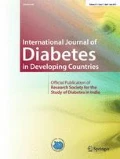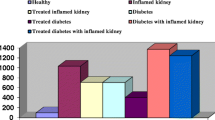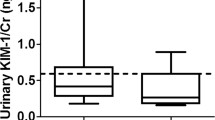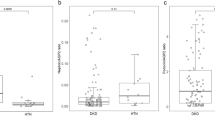Abstract
Renal damage is a serious major microvascular diabetic complication implicated in the death of diabetic patients, which would necessitate the need for new biomarkers to detect early stage of diabetic nephropathy (DN). Kidney injury molecule-1 (Kim-1), a type I transmembrane protein, is undetectable in normal kidneys but markedly induced in proximal tubules after ischemic and toxic injury. So, the present study was conducted to estimate and evaluate Kim-1 as a biomarker for DN. This cross-sectional study was carried out on 60 male and female type II diabetic patients (whose serum creatinine level was less than 2 mg/dL). Diabetic patients were classified as microalbuminuric with nephropathy (urinary albumin was 30–300 mg/dL) and normoalbuminuric without nephropathy (urinary albumin was <30 mg/dL). Twenty matched apparently healthy subjects were included as control group. Patients and controls were assessed for fasting blood glucose, glycosylated hemoglobin (HbA1c), serum creatinine, blood urea nitrogen (BUN), microalbuminuria, and urinary Kim-1. Urinary Kim-1 levels were elevated significantly tenfold in type II diabetic microalbuminuric patients as compared to the control group and normoalbuminuric diabetic patient. Urinary Kim-1 levels were positively correlated with microalbuminuria, serum creatinine, BUN, duration of diabetes, and BMI. Higher urinary Kim-1 level in T2D particularly in those with nephropathy and its correlation with urinary microalbumin, serum creatinine, blood urea, and BUN may reflect the role of Kim-1 as a biomarker for diagnosis and prognosis of diabetic nephropathy among T2D patients taking into account other risk factors.

Similar content being viewed by others
References
AL-Maskari AY, AL-Maskari MY, AL-Sudairy S. Oral manifestations and complications of diabetes mellitus. Sultan Qaboos Univ Med J. 2011;11(2):179–86.
Hall P. Prevention of progression in diabetic nephropathy. Diabet Spectr. 2006;19:18–24.
Valk EJ, Bruijn JA, Bajema IM. Diabetic nephropathy in humans: pathologic diversity. Curr Opin Nephrol. 2011;20(3):285–9.
Schena FP, Gesualdo L. Pathogenetic mechanisms of diabetic nephropathy. JASN. 2005;16(3):S30–3.
Lopez-Giacoman S, Madero M. Biomarkers in chronic kidney disease, from kidney function to kidney damage. World J Nephrol. 2015;4(1):57–73.
Devarajan P. Biomarkers for the early detection of acute kidney injury. Curr Opin Pediatr. 2011;2:194–200.
Ahmed SA, Hamed MA. Kidney injury molecule-1 as a predicting factor for inflamed kidney, diabetic and diabetic nephropathy Egyptian patients. J Diabet Metab Disord. 2015;14:6. doi:10.1186/s40200-015-0131-8.
Vaidya VS, Waikar SS, Ferguson MA, Collings FB, Sunderland K, Gioules C, et al. Urinary biomarkers for sensitive and specific detection of acute kidney injury in humans. Clin Transl Sci. 2008;1:200–8.
WHO, IDF. Definition and diagnosis of diabetes mellitus and intermediate hyperglycaemia, Report of a WHO/IDF consultation, WHO Document Production Services, 2006.
Fathy M, Elkady M, Fathy H, Awad S, Elmenshawy A. Estimation of renal tubular markers for predicting early stage diabetic nephropathy in Egyptian children with type I diabetes mellitus. Res J Med Med Sci. 2009;4(2):207–11.
Tietz NW. Textbook of clinical chemistry. Philadelphia: W.B. Saunders; 1986. p. 1271–81.
Tietz NW. Serum urea determination. In: Clinical guide to laboratory tests. 2nd edn. Philadelphia: W.B. Saunders Co; 1990. pp. 554–556
Watanabe N, Kamel S, Ohkubo A, Yamakna M. Urinary protein as measured with a pyrogallol red-molybdate complex manually and Hitachi 726 automated analyzer. Clin Chem. 1986;32:1551–4.
Hanas R, John G. International HBA1c Consensus Committee. 2010 consensus statement on the worldwide standardization of the hemoglobin A1C measurement. Diabetes Care. 2010;33(8):1903–4.
Levey AS, Stevens LA, Schmid CH, Zhang YL, Castro 3rd AF, Feldman HI, et al. A new equation to estimate glomerular filtration rate. Ann Intern Med. 2009;150(9):604–12.
Dawson B, Trapp RG. Basic & clinical biostatistics Ch 7–9. 3rd ed. USA: Large Medical Book/Mc Graw-Hill, Medical Publishing Division; 2001. pp161–218.
Vergouwe Y, Soedamah-Muthu SS, Zgibor J, Chaturvedi N, Forsblom C, Snell-Bergeon JK, et al. Progression to microalbuminuria in type 1 diabetes: development and validation of a prediction rule. Diabetologia. 2010;53(2):254–62.
Sheikh SA, Baig JA, Iqbal T, Kazmi T, Baig M, Husain SS. Prevalence of microalbuminuria with relation to glycemic control in type-2 diabetic patients in Karachi. J Ayub Med Coll Abbottabad. 2009;21(3):83–6.
Hebert CJ. Prevention kidney failure, primary care physicians must intervene earlier. Clev Clin J Med. 2003;70(4):337–44.
Powers AC. Diabetes mellitus. In: Jameson JL, editor. Harrison’s endocrinology. 1st ed. New York: McGraw-Hill; 2006. p. 303–4.
Maahs DM, Snively BM, Bell RA, Dolan L, Hirsch I, Imperatore G, et al. Higher prevalence of elevated albumin excretion in youth with type 2 than type 1 diabetes: the SEARCH for diabetes in youth study. Diabetes Care. 2007;30:2593–8.
Gross JL, de Azevedo MJ, Silveiro SP, Canani LH, Caramori ML, Zelmanovitz T. Diabetic nephropathy: diagnosis, prevention, and treatment. Diabetes Care. 2005;28(1):164–76.
Lim S, Kim DJ, Jeong IK, Son HS, Chung CH, Koh G, et al. A nationwide survey about the current status of glycemic control and complications in diabetic patients in 2006: the Committee of the Korean Diabetes Association on the epidemiology of diabetes mellitus. Korean Diabetes J. 2009;33:48–57.
Chowta NK, Pant P, Chowta MN. Microalbuminuria in diabetes mellitus: association with age, sex, weight, and creatinine clearance. Ind J Nephrol. 2009;19(2):53–6.
Kondaveeti SKKD, Mishra S, Kumar R, Shaker IA. Evaluation of glycated albumin and microalbuminuria as early risk markers of nephropathy in type 2 diabetes mellitus. J Clin Diagn Res. 2013;7(7):1280–3.
Maric C, Hall JE. Obesity, metabolic syndrome and diabetic nephropathy. Contrib Nephrol. 2011;170:28–35. doi:10.1159/000324941.
El-Wakf AM, Abbas TM, El-Baz RA, Mohammed WA. Role of hypertension and metabolic abnormalities in the development of diabetic nephropathy among Egyptian patients with type 2 diabetes. Nat Sci. 2011;7(9):220–8 (ISSN: 1545–1003).
Fares JE, Mona Kanaan M, Chaaya M, Sami T, Azar ST. Fluctuations in glycosylated hemoglobin (HbA1C) as a predictor for the development of diabetic nephropathy in type 1 diabetic patients. Int J Diabet Mellitus. 2010;2(1):10–4.
Van Timmeren MM, Van den Heuvel MC, Bailly V, Bakker SJL, Van Goor H, Stegeman CA. Tubular kidney injury molecule-1 (KIM-1) in human renal disease. J Path. 2007;212(2):209–17.
Gekle M. Renal tubule albumin transport. Annu Rev Physiol. 2005;67:573–94.
Han WK, Bailly V, Abichandani R, Thadhani R, Bonventre JV. Kidney injury molecule-1 (KIM-1): a novel biomarker for human renal proximal tubule injury. Kidney Int. 2002;62:237–44.
Conway BR, Manoharan D, Manoharan D, Jenks S, Dear JW, McLachlan S, et al. Measuring urinary tubular biomarkers in type 2 diabetes does not add prognostic value beyond established risk factors. Kidney Int. 2012;82:812–8.
Bonventre JV. Kidney injury molecule-1 (KIM-1): a specific and sensitive biomarker of kidney injury. Scand J Clin Lab Invest Suppl. 2008;241:78–83.
Acknowledgments
We acknowledge support from the Diabetes and Endocrinology Unit members of Internal Medicine Department of Tanta University Hospital, Egypt. Also, the authors are grateful to the members of Department of Biochemistry of Tanta University, Egypt.
Funding
The study is supported by the faculty of pharmacy, Tanta University, and faculty of medicine, Tanta University, Egypt.
Conflict of interest
The authors declare that they have no competing interests.
Author information
Authors and Affiliations
Corresponding author
Rights and permissions
About this article
Cite this article
El-Ashmawy, N.E., El-Zamarany, E.A., Khedr, N.F. et al. Kidney injury molecule-1 (Kim-1): an early biomarker for nephropathy in type II diabetic patients. Int J Diabetes Dev Ctries 35 (Suppl 3), 431–438 (2015). https://doi.org/10.1007/s13410-015-0403-3
Received:
Accepted:
Published:
Issue Date:
DOI: https://doi.org/10.1007/s13410-015-0403-3




